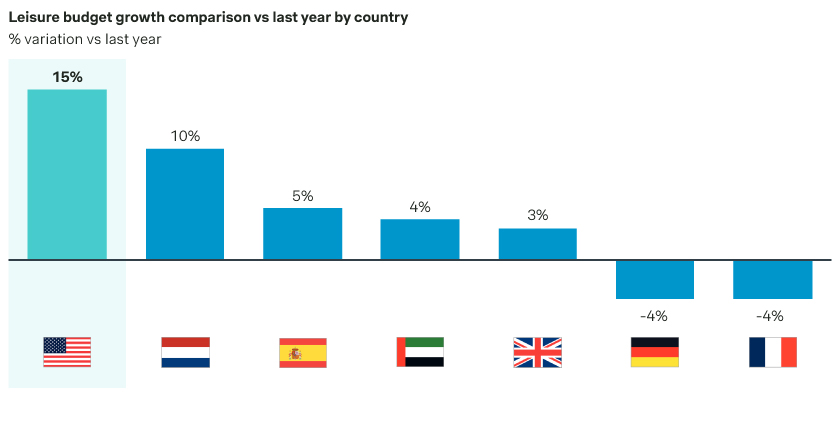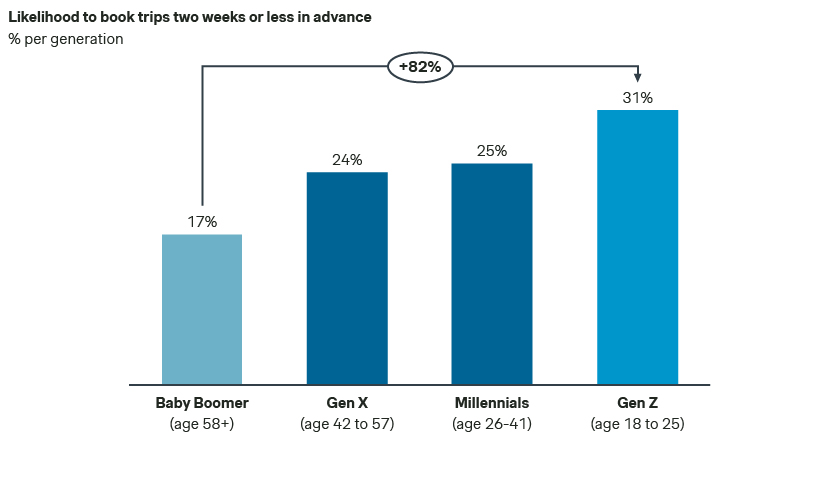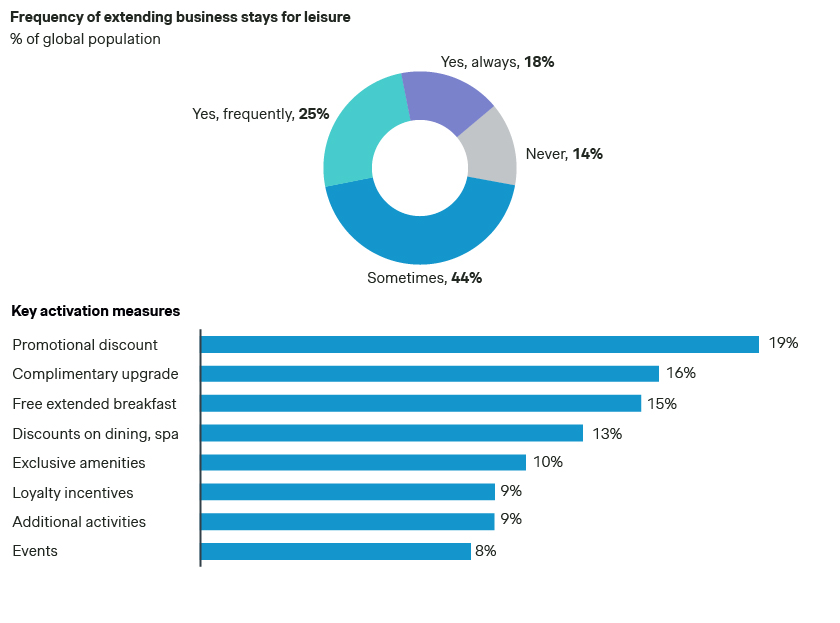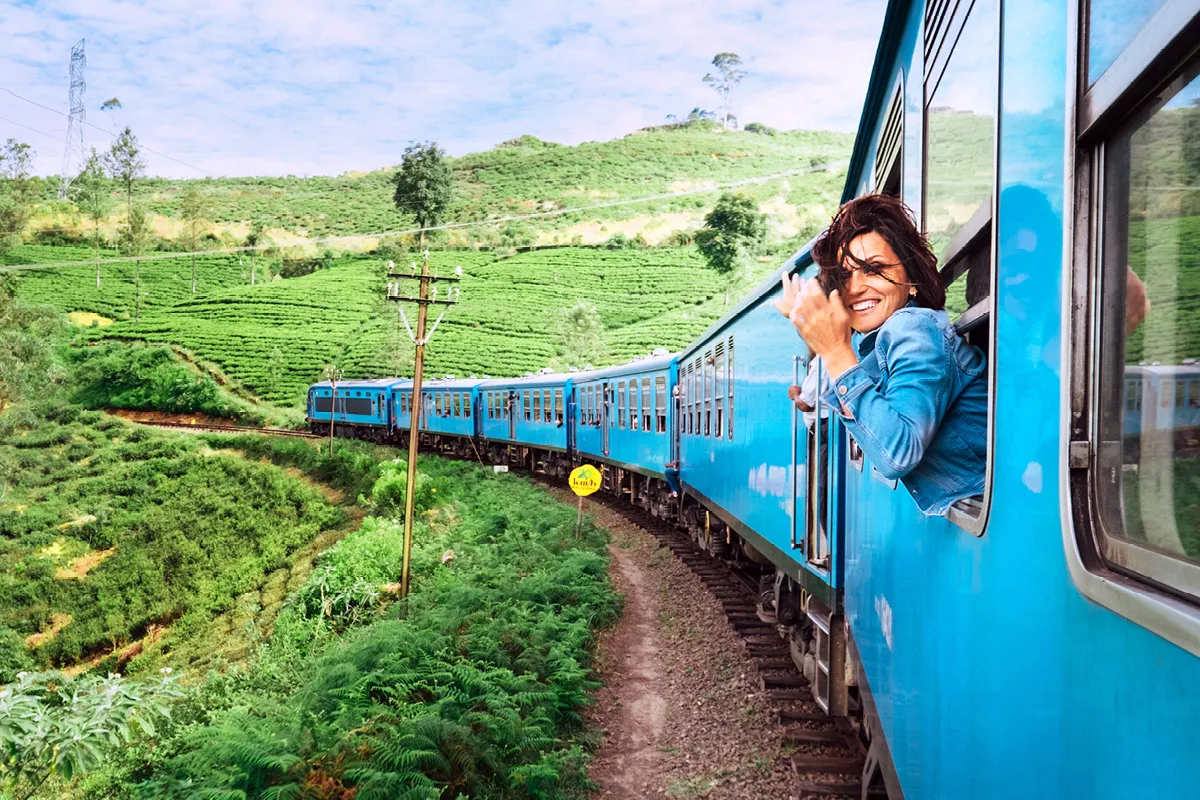Form placeholder. This will only show within the editor
The travel industry has experienced significant turbulence, including recent technology outages that disrupted global travel. However, the desire for exploration remains strong, driving the need for industry leaders to meet consumer preferences, remain competitive, and secure long-term profitability.
The US results to our Global Travel Trends Study reveal an increase in travel budgets, a shift towards spontaneous travel, and increased demand for premium travel. The imperative is clear: personalize, be guest forward, and prioritize experiences. The goal is not just to navigate these challenges but to emerge stronger, ready for the future of travel, and with a strategic plan for growth.
Exploring US Travel Budget Trends for 2024
In 2024, US travel budgets are set to soar, showcasing a robust 15.2% increase. This surge is notably led by Baby Boomers, ready to invest 24% more into their travels. But it’s not just Boomers setting the pace. Across generations, we observe significant upticks, signaling a universal eagerness to explore. What’s driving this trend? A glance at our Global Travel Trends Study reveals a key insight: spontaneity. Younger travelers, especially, are breaking the mold with an 82% higher likelihood of last-minute bookings. This pivot towards impromptu adventures represents a broader shift in travel dynamics.
Baby Boomers: Leading the charge with a 24% budget increase.
Generational Trends: Double-digit growth across the board.
Spontaneity: A marked preference among younger generations.

Why does this matter? As travel preferences evolve, understanding consumer budget trends becomes crucial for industry leaders. It’s not just about knowing where the market is headed but seizing the opportunity to meet these emerging needs head-on.
The call to action? Embrace these shifts. Tailor offerings to match the spontaneity and preferences that define today’s travelers. Let’s not just witness the change. Let’s lead it.
Priorities and behavior differ across generations
Younger generations are reshaping travel. Their approach? Bold and refreshing. Gen Z and Millennials are redefining what it means to explore, with a penchant for solo journeys and spur-of-the-moment decisions. This isn't just a trend. It's a movement towards independence and bespoke experiences. These travelers crave adventures that speak to their individual stories, seeking out moments rather than monuments. Baby Boomers on the other hand take longer trips and prioritize their preferred locations. On average, their international trips are 1.8 days longer than the ones of Gen Z and Millennials. Given many Baby Boomers have entered retirement, the oldest generation of travelers have more flexibility to travel for extended periods of time.
Independence: A key driver for Gen Z and Millennials.
Personalized Experiences: The new currency of travel.

What does this mean for the travel industry? Opportunity. Here lies a chance to cater to a demographic that values spontaneity over schedules, experiences over extravagance. It's a call to innovate, to design travel options that align with the dynamic lifestyles of younger explorers. Their preferences signal a shift to more agile, responsive travel planning.
The message is clear: adapt, personalize, and thrive. Engage with this wave of travelers, eager for discovery and ready to embark at a moment's notice. Let’s not just follow their lead; let’s pave new paths together.
The Rise of Luxury and Personalized Travel
The allure of luxury travel is unmistakable. It beckons with the promise of exclusivity and personalized experiences. High-reputation brands and unique destinations are at the forefront, catering to a sophisticated clientele. Luxury travelers, with their discerning tastes, seek out these experiences. They demand more than just high-quality hospitality amenities; they crave personalization, an experience tailored just for them.
Exclusivity: The heartbeat of luxury travel.
Personalization: Crafting unique journeys for every traveler.
This trend is not just growing; it's evolving, driven by an appetite for the exceptional. As disposable incomes rise, so does the quest for journeys that break the mold of conventional travel. Affluent travelers are not merely going places; they are collecting moments, curated to their individual preferences.
The call to action for the travel industry? Innovate. Elevate. Delight. Embrace the challenge of transforming travel into an art form, where every journey is a masterpiece, meticulously crafted to the traveler's desires.
Let’s engage with luxury seekers, creating unforgettable experiences that resonate on a personal level. This is not just an opportunity; it's an invitation to redefine luxury travel.

Business mixed with pleasure
The rise of bleisure—mixing business with leisure travel—shows a growing desire to blend work and play. Over 85% of business travelers at least sometimes extend their stay for leisure purposes.
Why? This shift is driven by the increasing flexibility in work schedules and the desire to maximize travel experiences. Modern technology and remote work options have made it easier for employees to stay connected while exploring new destinations. Incentives like discounts and upgrades are turning business trips into extended experiences.
For the travel industry, this signals a clear direction: develop offerings that ensure business travelers can seamlessly transition from meetings to sightseeing or relaxation. Embrace the shift, offer value, and make the journey as rewarding as the destination.

Sustainability and Destination Preferences
Sustainability in travel is a consideration for many with over 70% indicating that sustainability issues may affect their travel decisions. But only 24% of today’s travelers, across every generation, prioritize eco-friendly and less congested destinations. Awareness remains high but currently sustainable travel experiences are viewed as a nice-to-have rather than a need-to-have by travelers. The industry should remain proactive in their approach, ensuring readiness to deliver sustainable travel experiences if demand intensifies.
The message is clear: Innovate with intention, making sustainability an important element of travel but combing it with a world-class experience. Let's lead the way in shaping a future where travel respects our planet.
What’s Next for Travel Industry Leadership?
It’s challenging for travel organizations to maintain sustainable and long-term strategies when their profits are dependent upon consumer preferences and purchasing behaviors, compounded by Global events. Industry leaders should remain nimble and leverage emerging trends to drive growth.
Customer Loyalty Scheme Strategies: Develop and refine loyalty programs that reward repeat customers, enhance engagement, and foster brand loyalty. Tailored schemes can cater to diverse traveler profiles, ensuring a personalized approach that resonates with different customer segments.
Dynamic Pricing Strategies and Systems: Utilize advanced pricing algorithms to adjust rates dynamically based on market demand, competition, and traveler behavior. This approach not only maximizes revenue but also offers competitive pricing that can attract a broader audience.
Revenue Management Process Design: Streamline and optimize revenue management processes to ensure efficient use of resources and data-driven decision-making. By focusing on strategic planning and analysis, businesses can identify new revenue streams and improve profitability.
Discount and Promotion Management: Craft targeted discount and promotion campaigns that appeal to specific traveler demographics. Strategic promotions can boost bookings during off-peak seasons and increase customer retention.
Customer Base Management: Implement comprehensive strategies to understand and manage customer data, enabling more effective segmentation and personalized marketing. This approach ensures that offerings are relevant and compelling to each segment, enhancing overall satisfaction.
Cross- and Up-Selling Strategies: Leverage opportunities to offer complementary products and services that enhance the travel experience. Effective cross-selling and up-selling can increase the average transaction value and improve customer satisfaction.
Fare and Rate Structure Optimization: Regularly review and adjust fare structures to stay competitive in the market. Consider factors such as customer willingness to pay, competitor pricing, and market conditions to optimize rates and attract diverse traveler segments.
Finding the right balance of these levers within a strategy is essential for positioning a business for long-term success. To explore these opportunities further and tailor them to your specific needs, contact our team of experts for personalized guidance. Our specialists are ready to help you implement these strategies and drive growth in your organization. Let's work together to shape the future of travel and create exceptional experiences for your customers.
